Widescreen Weekend Program 2009
|
Read more
at in70mm.com The 70mm Newsletter |
| Text by: Thomas Hauerslev, editor, with thanks to Sheldon Hall and Wolfram Hannemann | Date: 21.03.2009 |
Thursday 19 March 2009 |
|
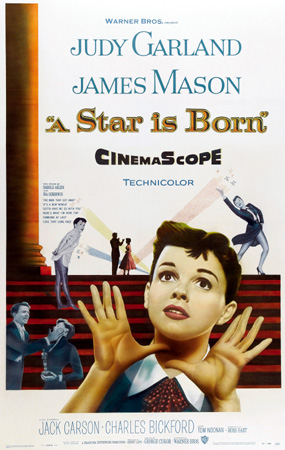 16.00 –
18.57
“A Star is Born”
(2:56).
Filmed in: 35mm 4 perforations, 24 frames per second.
Principal photography in: CinemaScope. 1984 restoration presented on:
The flat screen, in a 35mm CinemaScope print with 4-track Dolby A.
Aspect ratio: 2,55:1. Country of origin: USA. Production year:
1954.
Originally premiere:
29.09.1954, Los Angeles, USA. 16.00 –
18.57
“A Star is Born”
(2:56).
Filmed in: 35mm 4 perforations, 24 frames per second.
Principal photography in: CinemaScope. 1984 restoration presented on:
The flat screen, in a 35mm CinemaScope print with 4-track Dolby A.
Aspect ratio: 2,55:1. Country of origin: USA. Production year:
1954.
Originally premiere:
29.09.1954, Los Angeles, USA.Directed by George Cukor. Screenplay: Moss Hart. Produced by Vern Alves (associate producer), Sidney Luft (producer), Cinematography by Sam Leavitt (director of photography). Film Editing by Folmar Blangsted Judy Garland (Vicki Lester / Esther Blodgett), James Mason (Norman Maine), Jack Carson (Matt Libby), Charles Bickford (Oliver Niles). 1954 Academy Award Nominated: Best Actor in a Leading Role James Mason Best Actress in a Leading Role Judy Garland Best Art Direction-Set Decoration, Color Malcolm C. Bert, Gene Allen, Irene Sharaff, George James Hopkins Best Costume Design, Color Jean Louis, Mary Ann Nyberg, Irene Sharaff, Best Music, Original Song Harold Arlen (music) Ira Gershwin (lyrics) For the song "The Man that Got Away" Best Music, Scoring of a Musical Picture Ray Heindorf "A Star Is Born" is not included in the price of the delegate pass and tickets for this screening plus the Imax movies, must be purchased separately. "A Star Is Born" is specifically part of the James Mason: Enigmatic Elegance strand, celebrating the centenary of his birth. |
More
in 70mm reading: Widescreen Weekend 2009 • Gallery: 2009 • WSW Home • Through the Years • The Best of WSW • Academy of the WSW • Creating the WSW • Planning the WSW • Projecting the WSW • Home of CINERAMA • Projecting CINERAMA "Where Eagles Dare" - Cinema Retro ‘Movie Classics’ Special "Where Eagles Dare" - 40th Anniversary 1969 - 2009 Internet link: |
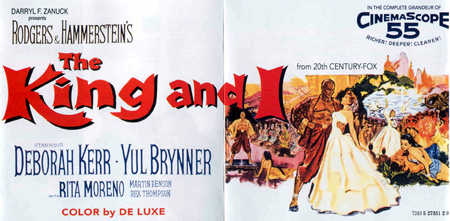 20.00 – 22.30
“The King and I”
(2:13)*).
Filmed in: 55mm 8 perforations, 24 frames per second.
Principal photography in: CinemaScope 55. Presented on:
The flat screen in a new restored 35mm CinemaScope 55 reduction print with 6-track Dolby Digital.
Aspect ratio: 2,55:1. Country of origin: USA. Production year:
1956.
Originally premiere: ROXY, New York, USA 28. June 1956. 70mm
version premiere: 23. March 1961 at the
Rivoli in New York,
USA. 20.00 – 22.30
“The King and I”
(2:13)*).
Filmed in: 55mm 8 perforations, 24 frames per second.
Principal photography in: CinemaScope 55. Presented on:
The flat screen in a new restored 35mm CinemaScope 55 reduction print with 6-track Dolby Digital.
Aspect ratio: 2,55:1. Country of origin: USA. Production year:
1956.
Originally premiere: ROXY, New York, USA 28. June 1956. 70mm
version premiere: 23. March 1961 at the
Rivoli in New York,
USA.*) 144 mins with overture, entr'acte and exit music (used in the 70mm version, not the 35mm) Directed by Walter Lang. Written by Margaret Landon (book "Anna and the King of Siam"). Oscar Hammerstein II (musical play). Ernest Lehman (screenplay). Produced by Charles Brackett. Original Music by Richard Rodgers. Cinematography by Leon Shamroy (director of photography). Film Editing by Robert Simpson. Deborah Kerr (Anna Leonowens), Yul Brynner (King Mongkut of Siam), Rita Moreno (Tuptim), Marni Nixon (Anna (singing voice)) New 35mm print courtesy Schaun Belston & Kevin Barret, 20th Century Fox Library Services, Los Angeles, USA 1957 Academy Award Wins: Best Actor in a Leading Role Yul Brynner Best Art Direction-Set Decoration, Color Lyle R. Wheeler, John DeCuir, Walter M. Scott, Paul S. Fox Best Costume Design, Color Irene Sharaff Best Music, Scoring of a Musical Picture Alfred Newman, Ken Darby Best Sound, Recording Carlton W. Faulkner (20th Century-Fox SSD) Academy Award Nominated: Best Actress in a Leading Role Deborah Kerr Best Cinematography, Color Leon Shamroy Best Director Walter Lang Best Picture Charles Brackett |
|
Friday 20 March 2009 |
|
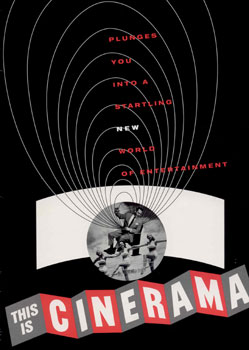 Developed by Fred Waller. Narrated by Lowell Thomas. Supervised by Michael Todd and Michael Todd Jr. Produced by Merian C. Cooper and Robert L. Bendick. Music by Cinerama Philharmonic Orchestra. Cinematography by Harry Squire. Print: National Media Museum This is the original Cinerama feature which launched the widescreen era, here presented in a recently struck print in the original three-strip format, with seven-track stereo sound. There is no narrative, merely a variety of 'attractions': the famous rollercoaster ride is followed by a series of musical and travelogue episodes culminating in an aerial tour of America. More than a technological curio, it's a document of its era. 1953 Academy Award Wins: Fred Waller (d. May 18, 1954) for designing and developing the multiple photographic and projection systems which culminated in Cinerama. Academy Award Nominated: Best Music, Scoring of a Dramatic or Comedy Picture |
|
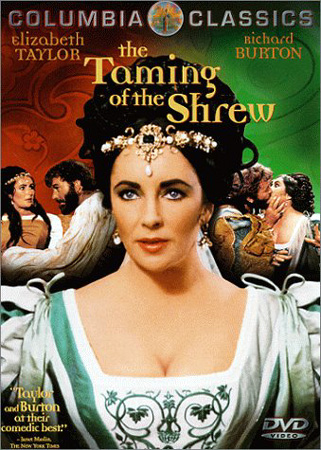 12.30 – 14.32 "The Taming of the Shrew" (2:02).
Filmed in:
35mm, 4 perforations, 24 frames per second.
Principal photography in: Panavision. Presented on:
The flat screen in a vintage 70mm print with 6-track magnetic stereo.
Aspect ratio: 2,21:1. Country of origin: USA. Production year:
1967
World Premiere: UK 27 February 1967 (London) (premiere: Royal Film Performance). 12.30 – 14.32 "The Taming of the Shrew" (2:02).
Filmed in:
35mm, 4 perforations, 24 frames per second.
Principal photography in: Panavision. Presented on:
The flat screen in a vintage 70mm print with 6-track magnetic stereo.
Aspect ratio: 2,21:1. Country of origin: USA. Production year:
1967
World Premiere: UK 27 February 1967 (London) (premiere: Royal Film Performance).
The 70mm blow-up version was first shown in the UK on 15 Feb 1973 at the Odeon, St Martin's Lane, London. Directed by Franco Zeffirelli. Franco Zeffirelli, Suso Cecchi d'Amico & Paul Dehn (screenplay). Produced by Richard McWhorter. Original Music by Nino Rota. Cinematography by Oswald Morris. Film Editing by Peter Taylor Elizabeth Taylor (Katharina), Richard Burton (Petruchio), Cyril Cusack (Grumio), Michael Hordern (Baptista), Vernon Dobtcheff (Pedant), Michael York (Lucentio) 1967 Academy Award Nominated: Best Art Direction-Set Decoration, Lorenzo Mongiardino, John DeCuir, Elven Webb, Giuseppe Mariani, Dario Simoni, Luigi Gervasi Best Costume Design Irene Sharaff, Danilo Donati |
|
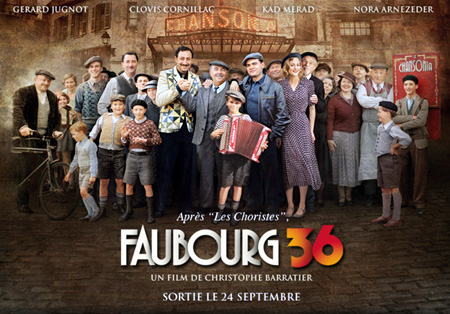 15.00 – 17.00 "Faubourg 36"
Filmed in:
35mm, 4 perforations, 24 frames per second.
Principal photography in: Panavision. Presented on:
The flat screen in a new 70mm print with 6-track DTS
stereo.
Aspect ratio: 2,21:1. Country of origin: France. Production year:
2008
World Premiere: Gaumont Opera cinema, 24.09.2008, France. Also screened at the Toronto Film Festival, Canada 6 September 2008. 15.00 – 17.00 "Faubourg 36"
Filmed in:
35mm, 4 perforations, 24 frames per second.
Principal photography in: Panavision. Presented on:
The flat screen in a new 70mm print with 6-track DTS
stereo.
Aspect ratio: 2,21:1. Country of origin: France. Production year:
2008
World Premiere: Gaumont Opera cinema, 24.09.2008, France. Also screened at the Toronto Film Festival, Canada 6 September 2008.Director: Christophe Barratier. Writer: Christophe Barratier (writer) Pierre Philippe (dialogue). Produced by: Original Music by Reinhardt Wagner. Cinematography by Tom Stern (director of photography). Film Editing by Yves Deschamps. Production Design by Jean Rabasse Gérard Jugnot (Pigoil), Clovis Cornillac (Milou). Kad Merad (Jacky Nora Arnezeder (Douce). Pierre Richard (Monsieur TSF), Bernard-Pierre Donnadieu (Galapiat), Maxence Perrin (Jojo), François Morel (Célestin The setting is spring 1936; a working-class district in the north of Paris. This neighborhood probably had a name once but now everyone simply calls it the Faubourg. In early may, three residents of the Faubourg - Pigoil, Milou, and Jacky - still sulk over the closing of the Chansonia four months ago. Supported by the locals who live to the rhythm of monsieur Tsf’s radio, the three friends decide to take hold of their destiny by producing the “hit” musical the Chansonia has always needed. With the help of the town, and the arrival of a mysterious and beautiful young actress named Duce, Pigoil, Milou, and Jacky bring the magic of the stage back to the Chansonia. Subtitled in English on-line by NMM's own Deb Singleton, as she speaks French!, by way of a lengthy PowerPoint presentation prepared by Symon on the basis of subtitle files provided by Pathé. From the recent subtitle test screening in Bradford: "Faubourg 36" looked absolutely beautiful and Deb did a fantastic job operating the subtitles. The quality was mightily impressive and several staff said it looked as though it had been filmed in 65mm. A very enjoyable film with some wonderful music and songs. Duncan McGregor "Faubourg 36" in 70mm in Paris, France "Faubourg 36" Official movie site 70mm print curtesy Pathe UK |
|
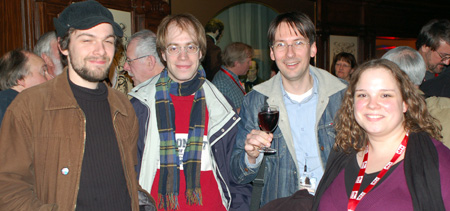 Markus
Vetter, Vincent Koch, Clemens Scherer and Melanie Hoffmann, - the German delegation. Image Thomas Hauerslev Markus
Vetter, Vincent Koch, Clemens Scherer and Melanie Hoffmann, - the German delegation. Image Thomas Hauerslev17:00 Reception for weekend delegates in the Kodak Gallery. Always a popular event Images from the 2008 reception |
|
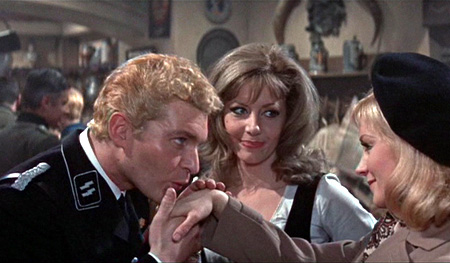 "Where Eagles Dare" - Screen talk
with
Derren Nesbitt "Where Eagles Dare" - Screen talk
with
Derren NesbittScreen shot from "Where Eagles Dare", with Derren Nesbitt, Ingrid Pitt and Mary Ure. Copyright MGM 1969 18.45 – 19.45 Screen talk interview with cast & crew of "Where Eagles Dare" Derren Nesbitt (19 June 1935) has confirmed his participation. One of the last surviving members (Clint Eastwood and Ingrid Pitt are still with us) of the cast of "Where Eagles Dare" reminiscences about his experiences on this classic war movie. We hope to be joined by other cast and crew for this special reunion. Rather intriguing British actor who first appeared on UK cinema & TV screens in the late 1950s, and quickly found steady work as a rather unpleasant or untrustworthy individual. His cold, yet cunning features had him appearing in guest roles on many UK TV series' including "The Adventures of Sir Lancelot" and "William Tell", and the 1960s then proved to be his busiest period of work! Nesbitt put in strong, intelligent performances in the WW1 aviation spectacle "The Blue Max" (1966), as a cold war agent pursuing Frank Sinatra in "The Naked Runner" (1967) and probably his best remembered role, as Major Von Hapen, an ice cold SS officer nearly foiling Clint Eastwood and Richard Burton plans in "Where Eagles Dare" (1968) The talented Nesbitt also wrote, directed and starred in the fairly tepid "The Amorous Milkman" (1975) and was kept busy through most of the 1970s in further espionage / action films. Unfortunately, demand for his talents waned heavily in the 1980s and early 1990s with appearances in only a handful of films. His last film appearance to date was in "Flawless" (2008). Derren Nesbitt's visit gallery IMDb Mini Biography By: firehouse44@hotmail.com + Wikipedia |
|
 20.00 – 22.55 "Where Eagles Dare" (2:38)
+ intermission. Filmed in:
35mm, 4 perforations, 24 frames per second.
Principal photography in: Panavision. Presented on:
The flat screen in a vintage 70mm print with 6-track magnetic stereo.
Aspect ratio: 2,21:1. Country of origin: USA. Production year:
1968
World Premiere *): 14.12.1968, Japan. 22.01.1969, Empire, Leicester
Square, London UK 20.00 – 22.55 "Where Eagles Dare" (2:38)
+ intermission. Filmed in:
35mm, 4 perforations, 24 frames per second.
Principal photography in: Panavision. Presented on:
The flat screen in a vintage 70mm print with 6-track magnetic stereo.
Aspect ratio: 2,21:1. Country of origin: USA. Production year:
1968
World Premiere *): 14.12.1968, Japan. 22.01.1969, Empire, Leicester
Square, London UK Richard Burton (Maj. Jonathan Smith, MC), Clint Eastwood (Lt. Morris Schaffer), Mary Ure (Mary Elison), Patrick Wymark (Col. Wyatt Turner, DSO MC), Michael Hordern (Adm. Rolland), Donald Houston (Capt. James Christiansen), Peter Barkworth (Edward Berkeley), William Squire (Capt. Philip Thomas), Robert Beatty (Gen. George Carnaby), Brook Williams (Sgt. Harrod), Neil McCarthy (Sgt. Jock MacPherson), Vincent Ball (Carpenter), Anton Diffring (SS-Standartenführer Kramer), Ferdy Mayne (Gen. Rosemeyer), Derren Nesbitt (SS-Sturmbannführer Von Hapen) *) 22 January 1969 was the date of the UK premiere, (at the Empire, Leicester Square (it interrupted a run of the 70mm version of "GONE WITH THE WIND"). It was given a trade press preview in an unfinished state, without the music score, in the US in early December 1968) the public run starting the following day. I’ve checked the materials I have on it (trade paper coverage and ads) and nowhere do they say “WORLD Premiere”, only “Gala Premiere”, so the WP was elsewhere, quite possibly in Japan. Sheldon Hall imdb.com list the film's Japanese opening date in late December 1968. Opened in Denmark 20.01.1969 as "European Premiere". Editor 40th anniversary screening sponsored by Cinema Retro. Cinema Retro ‘Movie Classics’ Special + 40th Anniversary 1969 - 2009 + Posters + Filming Locations |
|
Saturday 21 March 2009 |
|
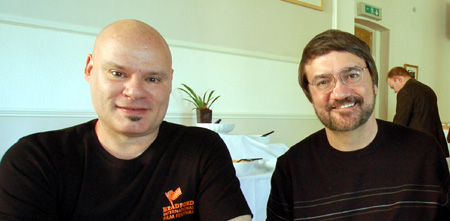 Randy Gitsch and Dave Strohmaier. Image by Thomas Hauerslev Randy Gitsch and Dave Strohmaier. Image by Thomas Hauerslev10.00 – 11.00 Cinerama Ventures. Dave Strohmaier and Randy Gitsch return to Widescreen Weekend for the 4th time to venture into a program of new items on our screen. Included will be the exciting story of rescuing the only surviving 3 panel print of "Cinerama's Russian Adventure", highlighted with an exclusive sampling of 18 minutes of selected 3 panel scenes from this rescued print. A tribute to the first "Super Cinerama" theater ever built: The Cooper Cinerama in Denver Colorado. A never before seen short subject commemorating the New Neon Movies in Dayton Ohio highlighting the efforts of John Harvey and Larry Smith. A nine minute behind the scenes video presenting the Arclight Hollywood Cinerama experience of showing "How The West Was Won", including interviews with John Sittig, director of Cinerama Inc. and long time veteran Cinerama projectionist Gunther Jung. There will also be an update on the current Cinerama news from Hollywood. David Strohmaier (Director-Editor-Writer) on imdb.com Randy Gitsch (Producer-Writer-Actor) on imdb.com |
|
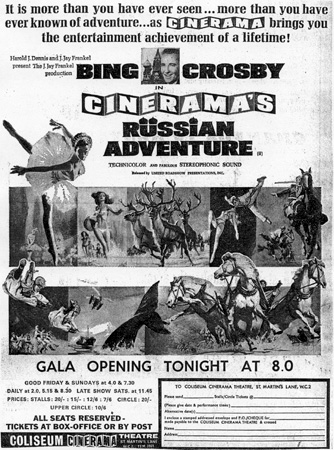 3-strip clip of "Cinerama's Russian Adventure".
Presented by David Strohmaier. The first 18
minutes of reel one, a bit faded but with very good contrast. 3-strip clip of "Cinerama's Russian Adventure".
Presented by David Strohmaier. The first 18
minutes of reel one, a bit faded but with very good contrast.Filmed in Sovcolor 3-strip Kinopanorama. Originally released March 29, 1966 in Chicago. Later optically printed to 70mm. Original film included sequences from: Great is my Country 28.02.1958 The Enchanted Mirror 1958 One hour of Unexpected Travels by Helicopter 1960 Fourth Programme of Panorama Films: "Circus Performance " and "On the Red Square" 1961 Naughty Curves 1961 With an Open Heart 1961 To the Antarctic for the Whales 1961 Amazing Hunting 1962 The Volga Flows On 1963 The film itself was extraordinarily interesting, as it had several scenes from Russian life filmed daringly by the Russians with their monstrous 3-panel Kinopanorama camera. Scenes included scenes from the Moscow metro trains, whale hunting in the Arctic, circus performing including a very young world renowned clown Mr. Oleg Popov, spectacular river rafting and the usual (boring) ballet scenes. Shown complete in 70mm during 2004 Wide Screen Weekend. See the poster 3-strip print thanks to John Sittig, Pacific Theatres, Hollywood. |
|
 11.15 – 14.30
“How the West Was Won”
(2:42) + intermission.
Filmed in:
3x35mm 6 perforations, 24 frames per second.
Principal photography in: Cinerama. Presented:
On the curved 11.15 – 14.30
“How the West Was Won”
(2:42) + intermission.
Filmed in:
3x35mm 6 perforations, 24 frames per second.
Principal photography in: Cinerama. Presented:
On the curved
Written by James R. Webb. Produced by Bernard Smith. Original Music by Ken Darby and Alfred Newman. Cinematography by William H. Daniels, Milton R. Krasner, Charles Lang and Joseph LaShelle. Directed by John Ford, Henry Hathaway and George Marshall. Carroll Baker (Eve Prescott Rawlings), Lee J. Cobb (Marshal Lou Ramsey), Henry Fonda (Jethro Stuart), Gregory Peck (Cleve Van Valen), Debbie Reynolds (Lilith 'Lily' Prescott), James Stewart (Linus Rawlings), Eli Wallach (Charlie Gant) There are westerns and there westerns. "How the West Was Won" is something very special on the deep curved Cinerama screen and 7 track stereo sound. Thanks to generous contributions from many of the fans, we have been able to keep this excellent print going to present the best three strip Cinerama film ever made. A hit at the Festival year after year, we just can't let this classic lie dormant. Bringing together three of the best Hollywood western directors, "How the West Was Won" tells the story of the development of the west from a pioneering family from the 1830s to the Civil War. The panoramic scenes across the three panels and the full curved screen are spectacular and the lift from Alfred Newman's extraordinary score is exhilarating. Cinerama is the only way to see the film, everything else palls by comparison. "How the West was Won" is presented in a new restored digital print with 5.1 uncompressed digital stereo. Remastering introduction by Dave Strohmaier including Tom March's 5 minute How The West Was Won location video. Academy Award Wins: Best Film Editing Harold F. Kress Best Sound Franklin Milton (M-G-M SSD) Best Writing, Story and Screenplay - Written Directly for the Screen, James R. Webb Academy Award Nominated: Best Art Direction-Set Decoration, Color George W. Davis, William Ferrari, Addison Hehr, Henry Grace, Don Greenwood Jr., Jack Mills Best Cinematography, Color William H. Daniels, Milton R. Krasner, Charles Lang, Joseph LaShelle Best Costume Design, Color, Walter Plunkett Best Music, Score - Substantially Original Alfred Newman, Ken Darby Best Picture Bernard Smith "How the West Was Won" - finally in CINERAMA out of one hole |
|
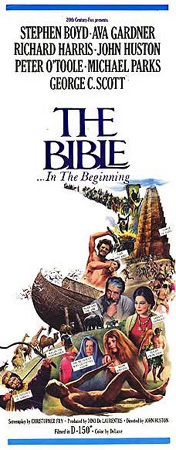 15.00 – 18.15
"The Bible...in the Beginning"
(2:54) (+ intermission).
Filmed in:
65mm, 5 perforations, 24 frames per second.
Principal photography in:
Dimension 150. Presented
on:
The curved 15.00 – 18.15
"The Bible...in the Beginning"
(2:54) (+ intermission).
Filmed in:
65mm, 5 perforations, 24 frames per second.
Principal photography in:
Dimension 150. Presented
on:
The curved
Director by John Huston. Screenplay by Vittorio Bonicelli and Christopher Fry. Produced by Dino De Laurentiis. Original music by Toshirô Mayuzumi. Cinematography by Giuseppe Rotunno. Edited by Ralph Kemplen Michael Parks (Adam), Ulla Bergryd (Eve), Richard Harris (Cain), John Huston (Noah / Voices of God, The Serpent / Offscreen Narrator), Stephen Boyd (Nimrod), George C. Scott (Abraham), Ava Gardner (Sarah), Peter O'Toole (The Three Angels), Gabriele Ferzetti (Lot), Franco Nero (Abel) About Dimension 150 and the Super Curvulon lens. New 70mm print courtesy Schaun Belston & Kevin Barret, 20th Century Fox Library Services, Los Angeles, USA Academy Award Nominated: Best Music, Original Music Score Toshirô Mayuzumi |
|
|
18.45 – 19.45 At the Cutting Edge: Digital
Cinema
With Darren Briggs This session will cover the current roll-out of D-Cinema and will examine its impact both in the UK and abroad. In addition it will look at Digital IMAX and provide a demonstration of Dolby’s digital 3D system. Sponsored by Arts Alliance Media with the support of Dolby Digital. |
|
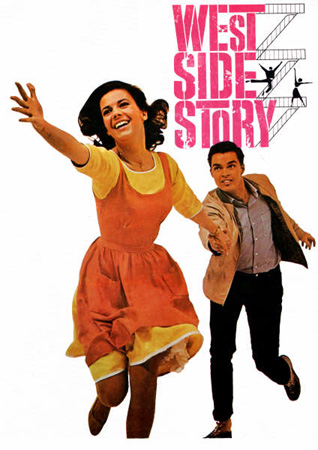 20.00 – 22.32 "West Side Story"
(2:32) + intermission (22:47). Filmed in: 65mm 5 perforations, 24 frames
per second. Principal photography in:
Super Panavision 70. Presented on: The curved 20.00 – 22.32 "West Side Story"
(2:32) + intermission (22:47). Filmed in: 65mm 5 perforations, 24 frames
per second. Principal photography in:
Super Panavision 70. Presented on: The curved
1962 Academy Award Wins: Best Actor in a Supporting Role George Chakiris Best Actress in a Supporting Role Rita Moreno Best Art Direction-Set Decoration, Color Boris Leven, Victor A. Gangelin Best Cinematography, Color Daniel L. Fapp Best Costume Design, Color Irene Sharaff Best Director Robert Wise, Jerome Robbins For the first time a directing award is being shared. Best Film Editing, Thomas Stanford Best Music, Scoring of a Musical Picture, Saul Chaplin, Johnny Green, Sid Ramin, Irwin Kostal Best Picture Robert Wise Best Sound Fred Hynes (Todd-AO SSD) Gordon Sawyer (Samuel Goldwyn SSD) Academy Award Nominated: Best Writing, Screenplay Based on Material from Another Medium, Ernest Lehman Official MGM site Considered one of the most popular musicals of all time, "West Side Story" earned director Robert Wise an Oscar for Best Director as well as nine other Academy Awards, including Best Picture. Realistically portrayed characters and their surroundings and expert editing complementing innovative dance sequences mark this highly stylized modern-day Romeo and Juliet tale. The stage is set in New York's Upper West Side in the 1950s, where the area's slums are plagued by racial tensions acted on by two rival gangs: the Puerto Rican Sharks and the Caucasian Jets. In the middle of this mess is young, innocent Maria (Natalie Wood), a Puerto Rican seamstress whose brother, Bernardo (George Chakiris), is the leader of the Sharks. Despite the warnings of Anita (Rita Moreno), Bernardo's fiery girlfriend, Maria falls in love with a young, hopeful Polish boy, Tony (Richard Beymer), who used to belong to the Jets, now headed by Riff (Russ Tamblyn). When Tony, on Maria's urging, tries to stop a rumble between the gangs, tragedy ensues, marking their dedicated love affair with violence and desperation. The infectious, lyrical landmark score by Leonard Bernstein and Stephen Sondheim help round out one of the greatest musical experiences ever captured on film. "West Side Story" was added to the Library of Congress National Film Registry in 1997. Have a look at the alternative Frankentrailer |
|
Sunday 22 March 2009 |
|
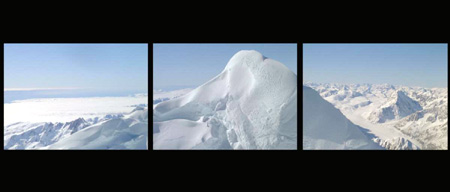 09:00
- 10:00 "This is New Zealand" 09:00
- 10:00 "This is New Zealand"From 37th Wellington Film Festival web site: Director: Hugh Macdonald. Year: 1969. Running time: 58 mins. NZ. Screenplay/Editors: Hugh Macdonald, David Jordan. Associate directors: David Jordan, Rob Ritchie. Producer: David H. Fowler. Executive producer: Geoffrey Scott. Photography: Kell Fowler, Murray Creed, Sam Grau. Camera assistant: Rob Wright. Location sound: Kit Rollings, Brian Shennan, Noel Sheridan. Sound editing and mixing: Kit Rollings. Associate mixer: Ron Skelley. Presented in CinemaScope on the flat screen. Digital restoration by: Archives New Zealand and Park Road Post When Britain joined the Common Market in 1969, New Zealand suddenly had to start promoting itself to the world, in order to develop alternative markets for our goods. One of the ways it did so was to take part in Expo 70, in Osaka, Japan. The star attraction at that event was a revolutionary 20-minute film made by the National Film Unit that introduced viewers to New Zealand in a glorious three-screen (and three-camera) presentation. With highly inventive camera work and editing, it showed everyone where we are, who we are, and - taking advantage of the super-widescreen format - what a spectacularly beautiful land we live in. The film was seen by more than two million people at Expo 70, and by 350,000 more when it returned home afterwards. Hidden from view since that time, this landmark film has been given a stunning restoration by Archives New Zealand and Park Road Post, and it looks - and sounds (now in 5.1 digital) - better than it ever has before. Print courtesy of Archives New Zealand "This is New Zealand" 3-strip EXPO Film From New Zealand Bob Jessopp: I had organised clearance for this from the National Film Archives through a friend and I believe Bill Lawrence was looking after this. It has now been put onto single 35mm film and looks mighty. I saw it projected onto a 100ft screen and it had people in the audience in tears. I kid you not. I am sure if you do screen it you will not be disappointed. |
|
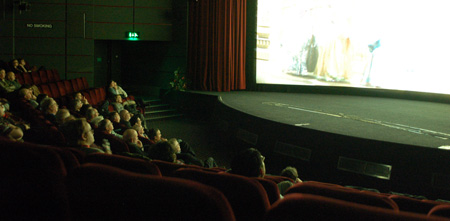 10:00 – 12:30 Cineramacana including the odd surprise and the Academy of the
Widescreen Weekend presentation. 10:00 – 12:30 Cineramacana including the odd surprise and the Academy of the
Widescreen Weekend presentation.One of the most popular events of the Widescreen Weekend and a great way to wake up on a Sunday morning, Cineramacana brings together all those little bits and pieces that lie around in people’s cupboards or on dusty shelves in archives and seldom see the light of a projector. Over the years there have been some magical discoveries and nobody knows what will be shown until the event itself. Even then there is the occasional surprise. Randy Gitsch has a brief History on 70mm Cinerama shorts he will use to introduce "Bridge to Space" (1968) (18 minutes, faded), directed by "Cinerama Holiday", "Windjammer" and "Sky over Holland" widescreen veteran Robert Gaffney, with Charles Trieschmann producing for NASA and Seneca Productions, and "Concorde" (1970) (around 20 minutes, faded), directed by Pierre Jallaud for Open University Productions, are the two films. Dion Hanson’s presentation on the projection room refurbishment 15 – 20 minutes. And there will just be time for the traditional Audience on stage photograph of all the WSW delegates. |
|
  "Tanakh Bibelen Al-Quran" (4'20'').
Filmed
in:
65mm, 5 perforations, 24 frames per second.
Principal photography in:
MCS-70
Superpanorama. Presented:
On the curved screen in 70mm. Sound:
DTS 6-track. Aspect ratio: 2,21:1. Country of origin:
Norway. Production year:
2007
35mm World Premiere: October 2007, Bergen, Norway, UK 70mm Premiere:
22.03.2009 Pictureville, Bradford, UK "Tanakh Bibelen Al-Quran" (4'20'').
Filmed
in:
65mm, 5 perforations, 24 frames per second.
Principal photography in:
MCS-70
Superpanorama. Presented:
On the curved screen in 70mm. Sound:
DTS 6-track. Aspect ratio: 2,21:1. Country of origin:
Norway. Production year:
2007
35mm World Premiere: October 2007, Bergen, Norway, UK 70mm Premiere:
22.03.2009 Pictureville, Bradford, UKDirector and screenplay: Ole Mads Sirks Vevle. Photography and editor: Morten Skallerud. Composer: Music published by Touch Music. Sound: B.J. Nilsen. Producer: Ingvild Hellesøy. Production company: Solepropriatorship Ole Mads Sirks Vevle. Genre: Animation. Laboratory: Gulliver, Paris v/Simone Appleby. Technical support: Dominique Benichetti. Sound mix: Europa Post Production, Stockholm, Gabor Pasztor. Financed by: Vestnorsk Filmfond, with thanks to Irmelin Nordahl and Hans Dragesund. Norsk Filmfond, with thanks to Peter Bøe. Fond for Lyd og Bilde. Summary: One God. One movie. One revelation. 3000 years after the first records of the biblical writings, this movie presents a complete screen version of the Hebrew Bible, the Christian Bible and the Arabic Quran. Nothing is added and nothing is taken away. Festival participation: 2007 Bergen International Film Festival. 2008 Scandinavian Film Festival, Bonn, Germany. 2008 Norwegian Short Film Festival, Grimstad The making of "Tanakh Bibelen al-Quran", www.olemadssirksvevle.com, Norwegian Film Institute Director's mini biography: Ole Mads Sirks Vevle (b. 1971) won two prizes during the Critics Week at the 2003 Cannes Film Festival for his short "Love is the Law" (2003), which was co-directed by Eivind Tolås. Vevle was educated at the Nordland Art and Film School, and has made numerous short films and installations. Filmography: 2007: "Tanakh Bibelen Al-Quran" 2006: "Tungetale ved første møte" 2005: "My Loneliness is Killing Me" 2004: "But What's It All About?" 2003: "Love is the Law" 2001: "Int. Morning. Bedroom" 1999: "The Holy Bible" MCS 70 - Superpanorama films |
|
|
13.00 – 13.30 Richard Burton: Lion of the Welsh presented by Tony Earnshaw
|
|
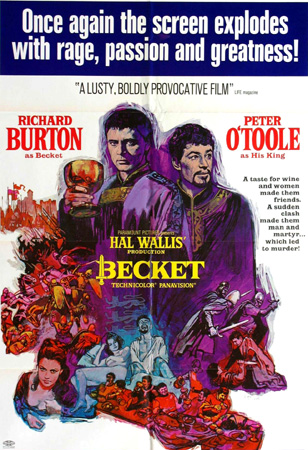 13.30 – 16.15 "Becket"
(2:28) + intermission.
Filmed in:
35mm, 4 perforations, 24 frames per second.
Principal photography in: Panavision. Presented on:
The
flat screen in a vintage Panavision 70mm print with 6-track magnetic stereo.
Aspect ratio: 2,21:1. Country of origin: USA. Production year:
1964
World Premiere: 11.03.1964, US. English premiere:
Plaza, Lower Regent Street, London, on 25 March, following the premiere run
of "Zulu". "Becket" was the first film shown at the Plaza in
70mm, which was installed for the occasion. 13.30 – 16.15 "Becket"
(2:28) + intermission.
Filmed in:
35mm, 4 perforations, 24 frames per second.
Principal photography in: Panavision. Presented on:
The
flat screen in a vintage Panavision 70mm print with 6-track magnetic stereo.
Aspect ratio: 2,21:1. Country of origin: USA. Production year:
1964
World Premiere: 11.03.1964, US. English premiere:
Plaza, Lower Regent Street, London, on 25 March, following the premiere run
of "Zulu". "Becket" was the first film shown at the Plaza in
70mm, which was installed for the occasion. Directed by Peter Glenville. Writing credits Edward Anhalt. Produced by Hal B. Wallis. Original Music by Laurence Rosenthal. Cinematography by Geoffrey Unsworth (director of photography). Film Editing by Anne V. Coates Richard Burton (Thomas à Becket), Peter O'Toole (King Henry II), John Gielgud (King Louis VII of France), Donald Wolfit (Bishop Folliot), Pamela Brown (Queen Eleanor [of Aquitaine], Siân Phillips (Gwendolen) 1965 Academy Award Wins: Best Writing, Screenplay Based on Material from Another Medium Edward Anhalt. Academy Award Nominated: Best Actor in a Leading Role Richard Burton Best Actor in a Leading Role Peter O'Toole Best Actor in a Supporting Role John Gielgud Best Art Direction-Set Decoration, Color John Bryan, Maurice Carter, Patrick McLoughlin, Robert Cartwright Best Cinematography, Color Geoffrey Unsworth Best Costume Design, Color Margaret Furse Best Director Peter Glenville Best Film Editing Anne V. Coates Best Music, Score - Substantially Original Laurence Rosenthal Best Picture Hal B. Wallis Best Sound John Cox (Shepperton SSD) Classic struggle between Church and Monarchy. Thomas Becket and King Henry Plantagenet engage in one of the most famous power struggles in English history. When Becket first becomes chancellor and later Archbishop of Canterbury, a rift grows between Henry II and his old friend. Some eager drunken knights trying to please the disgruntled monarch assassinate the cleric in the cathedral. Two of the finest actors of their generation, Burton and O'Toole, square off in this splendid production of Jean Anouilh's 1959 play. The lifelong friendship of Henry II and the Archbishop of Canterbury, Thomas Becket, is tested and ends in tragedy as Becket grows more confident and thoughtful in his position. Academy Award Nominations: 12, including Best Picture, Best Director, Best Actor- Richard Burton, Best Actor--Peter O'Toole. Academy Awards: Best (Adapted) Screenplay (Edward Anhalt). Re-release poster from eatbrie.com "Becket" was recently restored. Here are the details from the official "Becket" web site from MPI Media Group: With the original 35mm conformed negative missing, the restoration team set to work on the best available elements: the black & white YCM (yellow, cyan, magenta) separation protection masters. After much time-consuming labor and color timing, and under careful supervision by Michael Pogorzelski, director of the Academy Film Archive, a recombined color interpositive was created by YCM Labs of Burbank, California. Meanwhile, the audio restoration team at Chace Productions in Burbank, CA, worked on the original 35mm magnetic tracks. The tracks were in an advanced state of decomposition and shedding significantly to the point of clogging the heads every few feet. In the end, Chace managed to not only faithfully reproduce the original mono soundtrack, but also create breathtaking new 2.0 stereo and 5.1 Dolby Digital soundtracks. With generous technical and financial support provided by the Film Foundation and the Academy of Motion Picture Arts and Sciences, the MPI Media Group is proud to present the beautifully restored "Becket." 70mm print curtesy the Kino Mir 70 cinema, Krnov, Czeck Republic |
|
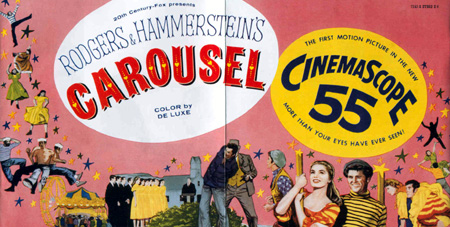 16.45 – 18.55 "Carousel"
(2:07).
Filmed in: 55mm 8 perforations, 24 frames per second.
Principal photography in: CinemaScope 55. Presented on:
The flat screen in a new restored 35mm CinemaScope 55 reduction print with 6-track Dolby Digital.
Aspect ratio: 2,55:1. Country of origin: USA. Production year:
1956.
World Premiere: 28.06.1956 ROXY, New York, USA (ran for 8 weeks). 16.45 – 18.55 "Carousel"
(2:07).
Filmed in: 55mm 8 perforations, 24 frames per second.
Principal photography in: CinemaScope 55. Presented on:
The flat screen in a new restored 35mm CinemaScope 55 reduction print with 6-track Dolby Digital.
Aspect ratio: 2,55:1. Country of origin: USA. Production year:
1956.
World Premiere: 28.06.1956 ROXY, New York, USA (ran for 8 weeks).Directed by Henry King. Writing credits Phoebe Ephron & Henry Ephron. Produced by Henry Ephron. Cinematography by Charles G. Clarke. Film Editing by William Reynolds Gordon MacRae (Billy Bigelow), Shirley Jones (Julie Jordan), Cameron Mitchell (Jigger Craigin), Barbara Ruick (Carrie Pipperidge), Claramae Turner (Cousin Nettie) New 35mm print courtesy Schaun Belston & Kevin Barret, 20th Century Fox Library Services, Los Angeles, USA From Wikipedia: The story revolves around Billy Bigelow, a rough-talking, macho, handsome carousel barker, and Julie Jordan, a young, innocent mill worker. They fall in love, but both are fired from their jobs for different reasons - Billy because he paid too much attention to Julie, and Julie because she stayed out past the curfew imposed by the understanding but stern mill owner, Mr. Bascombe. The two marry and go to live at the seaside spa of her cousin Nettie, but Billy becomes bitter because he is unable to find work, and in his frustration, strikes Julie (this moment is not shown at all in the film). Mrs. Mullin,the jealous carousel owner who is infatuated with him, hears of this and goes to Nettie's to offer Billy his old job back, but will not re-hire him unless he leaves his wife. Billy seems to be considering the idea when Julie asks to talk privately. Julie tells him she is pregnant and Billy is overjoyed and overly concerned about her health,- trying to help her up the stairs- and refuses Mrs. Mullins offer.He sings most of his soliloquy about playing and having fun with 'his boy,' then realises it may be a girl, and because of this he sees he needs something to offer his daughter, singing his resolution to do anything, even stealing, to support his little girl. So, concerned about not being able to provide for his child, Billy secretly agrees to join his no-good pal Jigger Craigin in robbing the wealthy Bascombe. On the boat ride with Mr. Snow and his intended to the clanbake that night however he appears uncomfortable and uneasy in mind. During the clambake Jigger tells Mr. Snows fiance that he'll show her how to defend herself. Mr. Snow walks in just in time to see her over his shoulder. He is upset and tells her the engagement is off. During the annual clambake treasure hunt the two men sneak away. They play cards to pass the time till the robbery, playing on credit of the money they will steal. The man they are to rob has a gun and in trying to escape him he is accidently killed on his own knife. Julie gets to him hardly a minute before he dies. His last words are "Julie...hold my hand-tighter... tighter..." The carosel owner Mrs. Mullin arrives desperate to see him just after his death. Fifteen years later, in the other world (apparently the back door of Heaven), he is told that he can return to Earth for one day to make amends. Billy returns to find his daughter Louise emotionally scarred because she is constantly taunted over the fact that her father tried to commit a robbery. Billy, not telling her who he is, makes himself visible, tries to cheer her up, and gives her a star that he stole from Heaven. Louise refuses it, frightened, and Billy, in desperation, slaps her hand. She rushes inside the house and informs Julie of what happened, saying that she did not feel a slap, but a kiss. Billy tries to make himself invisible before Julie can see him, but she has glimpsed him for just a split second, and senses that he has come back for a reason. Billy asks his Heavenly Guide for permission to go to Louise's high school graduation, and there he silently gives both her and Julie the confidence they need and the knowledge that, in spite of everything, he loved Julie. |
|
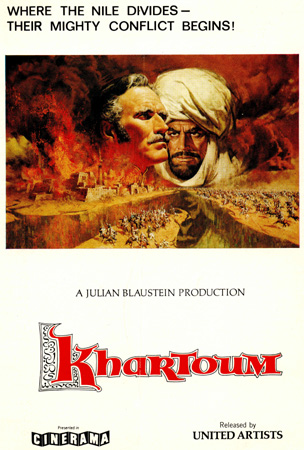 19.30 – 21.44 "Khartoum"
(2:14) + intermission (22:00). Filmed in: 65mm 5 perforations, 24 frames
per second. Principal photography in:
Ultra Panavision 70.
Presented on: The curved 19.30 – 21.44 "Khartoum"
(2:14) + intermission (22:00). Filmed in: 65mm 5 perforations, 24 frames
per second. Principal photography in:
Ultra Panavision 70.
Presented on: The curved
Director: Basil Dearden. Photography: Edward Scaife. Music by: Frank Cordell. Produced by Julian Blaustein. Film Editing by Fergus McDonell Charlton Heston (Gen. Charles 'Chinese' Gordon), Laurence Olivier (The Mahdi), Richard Johnson (Col. J.D.H. Stewart), Ralph Richardson (William Gladstone), Alexander Knox (Sir Evelyn Baring) Academy Award Nominated: Best Writing, Story and Screenplay - Written Directly for the Screen Robert Ardrey From Wikipedia: The film is about the last months before the British lost their emplacement in Sudan - in theory a subject territory of Egypt - in January 1885. Britain had occupied, but did not formally annex, Egypt in 1883. This is why Gordon, who is technically the "Egyptian" governor of the Sudan, wears a red Egyptian fez. In 1883, 10,000 untrained Egyptian troops under British command in Sudan are lured into the desert and slaughtered by Arab tribesmen under the leadership of the Mahdi, a religious fanatic who believes he is the "expected one of Mohammed." As a result of the massacre, Britain's Prime Minister William Gladstone (Ralph Richardson) reluctantly sends one of England's great military men, Gen. Charles Gordon, to Khartoum with orders to evacuate troops and civilians. Gordon, a brandy and Bible loving soldier nicknamed "Chinese" because of the 6 years he spent in the East eliminating the centuries-old slave traffic, is told that his mission must remain unofficial and that he has no authority to act in the name of the Queen. Although Gordon is hailed in Khartoum as a savior, he and his only aide, Col. J. D. H. Stewart (Richard Johnson), are unable to negotiate with the Mahdi. In England, Gladstone, informed of the increasing hopelessness of the situation, orders Gordon home; but, as fanatical in his own right as the Mahdi, Gordon refuses. Following the murder of Stewart, a final confrontation takes place between the two men, and both assert that they welcome death if dying brings about the destruction of their enemy. Soon, Gordon's small army faces the onslaught of 100,000 Arabs. Khartoum falls, and Gordon is slain by a dervish's spear. His head is mounted on a pole and brought before the Mahdi. Outraged, the Mahdi screams that he forbade such an action. Some months later, the British, under the command of Major Kitchener (Peter Arne), retake the besieged city and Gordon is honored as a national hero. The political origins of the Khartoum affair are unclear. The film postulates a meeting between the Prime Minister, Mr. Gladstone (correctly shown wearing a finger-stall to cover a finger lost in a shooting accident as a young man), and other officials, which Gladstone ends by declaring never to have taken place. The secret meeting between Gordon and the Mahdi in the Mahdist camp, as portrayed in the film, is entirely fictional. The final shot of Gordon descending a staircase before being speared to death, is based on a famous painting. Major Kitchener (Peter Arne), who played a role in Gen. Wolseley's (Nigel Green) relief expedition, was himself later a famous general and commanded the Anglo-Egyptian conquest of the Sudan in 1898. He was known thereafter as Lord Kitchener of Khartoum. |
|
Monday 23 March 2009 |
|
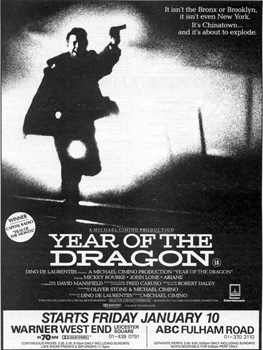 "Year of the Dragon"
(2:14).
Filmed in:
35mm, 4 perforations, 24 frames per second.
Principal photography in: Panavision. Presented on:
The flat screen in a vintage 70mm print with 6-track magnetic Dolby
stereo.
Aspect ratio: 2,21:1. Country of origin: USA. Production year:
1985
World Premiere: 16.08.1985, USA "Year of the Dragon"
(2:14).
Filmed in:
35mm, 4 perforations, 24 frames per second.
Principal photography in: Panavision. Presented on:
The flat screen in a vintage 70mm print with 6-track magnetic Dolby
stereo.
Aspect ratio: 2,21:1. Country of origin: USA. Production year:
1985
World Premiere: 16.08.1985, USADirected by Michael Cimino. Screenplay Oliver Stone and Michael Cimino. Produced by Dino De Laurentiis. Original Music by David Mansfield. Cinematography by Alex Thomson. Film Editing by Noëlle Boisson and Françoise Bonnot Mickey Rourke (Capt. Stanley White), John Lone (Joey Tai), Ariane (Tracy Tzu), Leonard Termo (Angelo Rizzo), Raymond J. Barry (Louis Bukowski), Caroline Kava (Connie White) From Wikipedia: Mickey Rourke plays Stanley White, a decorated police captain and Vietnam War veteran who is assigned to New York City's Chinatown, which he makes his personal mission to rid of crime. John Lone plays Joey Tai, a young man who ruthlessly rises up to become the head of the Chinese triad societies, and as a result of his ambition, creates a high profile both for himself and the triads' activities. Together, they end the uneasy truce that has existed between the triads and the police precinct. The film is an exploration of gangs, the illegal drug trade, ethnicity, racism, and stereotypes. |
|
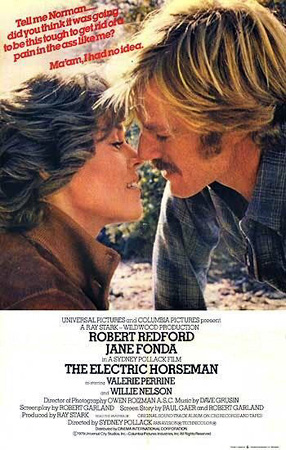 12.45 – 14.45
"The Electric Horseman"
(2:00).
Filmed in:
35mm, 4 perforations, 24 frames per second.
Principal photography in: Panavision. Presented on:
The flat screen in
Panavision 70mm with 6-track magnetic stereo.
Aspect ratio: 2,21:1. Country of origin: USA. Production year:
1979
World Premiere: 12.45 – 14.45
"The Electric Horseman"
(2:00).
Filmed in:
35mm, 4 perforations, 24 frames per second.
Principal photography in: Panavision. Presented on:
The flat screen in
Panavision 70mm with 6-track magnetic stereo.
Aspect ratio: 2,21:1. Country of origin: USA. Production year:
1979
World Premiere:
Directed by Sydney Pollack. Screenplay Robert Garland. Produced by Ronald L. Schwary & Ray Stark. Original Music by Dave Grusin. Cinematography by Owen Roizman, Film Editing by Sheldon Kahn Robert Redford (Norman 'Sonny' Steele), Jane Fonda (Alice 'Hallie' Martin), Valerie Perrine (Charlotta Steele); Willie Nelson (Wendell Hickson), John Saxon (Hunt Sears), Sydney Pollack (Man who makes pass at Alice) From Wikipedia: Sonny Steele (Robert Redford) is a former championship rodeo rider who has sold out to a business conglomerate and is now reduced to making public appearances to sell a brand of breakfast cereal. Prior to making a Las Vegas promotional appearance to ride the champion thoroughbred Rising Star, Sonny discovers the horse has been drugged and is injured. Identifying with the plight of the horse and disillusioned with the present state of his life, Sonny decides to kidnap the animal and travel cross country in order to release it in a remote canyon where herds of wild horses live. Hallie Martin (Jane Fonda), a television reporter eager to be the first to break the Rising Star story, catches up with Sonny and follows him on his unusual quest across the countryside. While en route, the unlikely pair fall in love, all the while having to avoid the pursuing authorities. |
|
|
Go: back
- top -
back issues
- news index Updated 22-01-25 |
|
